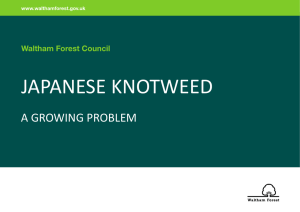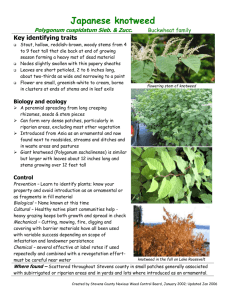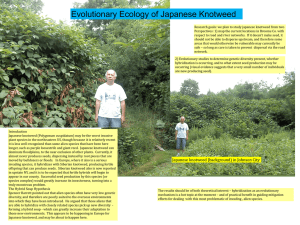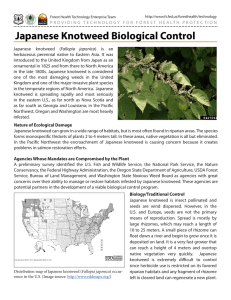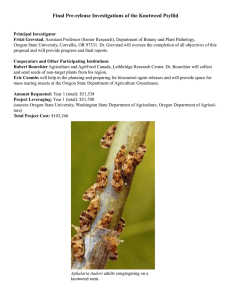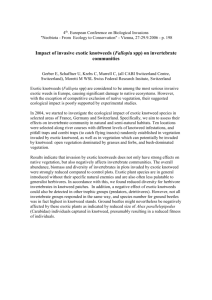Release and Evaluation of Impact for the Knotweed Psyllid Aphalara itadori
advertisement
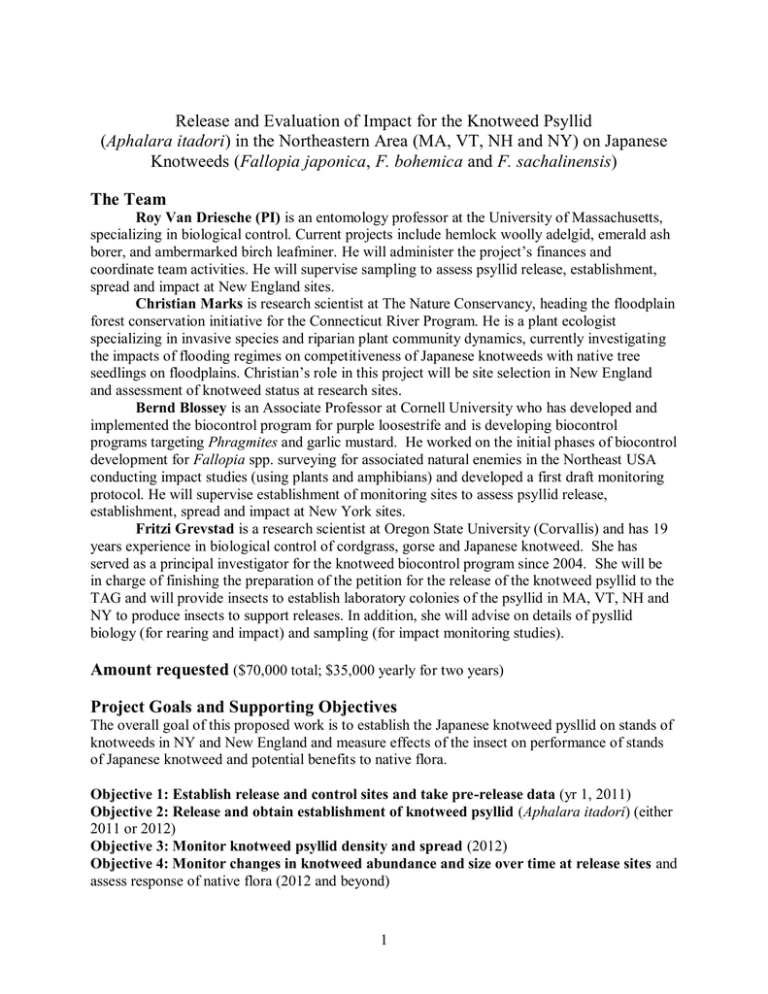
Release and Evaluation of Impact for the Knotweed Psyllid (Aphalara itadori) in the Northeastern Area (MA, VT, NH and NY) on Japanese Knotweeds (Fallopia japonica, F. bohemica and F. sachalinensis) The Team Roy Van Driesche (PI) is an entomology professor at the University of Massachusetts, specializing in biological control. Current projects include hemlock woolly adelgid, emerald ash borer, and ambermarked birch leafminer. He will administer the project’s finances and coordinate team activities. He will supervise sampling to assess psyllid release, establishment, spread and impact at New England sites. Christian Marks is research scientist at The Nature Conservancy, heading the floodplain forest conservation initiative for the Connecticut River Program. He is a plant ecologist specializing in invasive species and riparian plant community dynamics, currently investigating the impacts of flooding regimes on competitiveness of Japanese knotweeds with native tree seedlings on floodplains. Christian’s role in this project will be site selection in New England and assessment of knotweed status at research sites. Bernd Blossey is an Associate Professor at Cornell University who has developed and implemented the biocontrol program for purple loosestrife and is developing biocontrol programs targeting Phragmites and garlic mustard. He worked on the initial phases of biocontrol development for Fallopia spp. surveying for associated natural enemies in the Northeast USA conducting impact studies (using plants and amphibians) and developed a first draft monitoring protocol. He will supervise establishment of monitoring sites to assess psyllid release, establishment, spread and impact at New York sites. Fritzi Grevstad is a research scientist at Oregon State University (Corvallis) and has 19 years experience in biological control of cordgrass, gorse and Japanese knotweed. She has served as a principal investigator for the knotweed biocontrol program since 2004. She will be in charge of finishing the preparation of the petition for the release of the knotweed psyllid to the TAG and will provide insects to establish laboratory colonies of the psyllid in MA, VT, NH and NY to produce insects to support releases. In addition, she will advise on details of pysllid biology (for rearing and impact) and sampling (for impact monitoring studies). Amount requested ($70,000 total; $35,000 yearly for two years) Project Goals and Supporting Objectives The overall goal of this proposed work is to establish the Japanese knotweed pysllid on stands of knotweeds in NY and New England and measure effects of the insect on performance of stands of Japanese knotweed and potential benefits to native flora. Objective 1: Establish release and control sites and take pre-release data (yr 1, 2011) Objective 2: Release and obtain establishment of knotweed psyllid (Aphalara itadori) (either 2011 or 2012) Objective 3: Monitor knotweed psyllid density and spread (2012) Objective 4: Monitor changes in knotweed abundance and size over time at release sites and assess response of native flora (2012 and beyond) 1 Project Justification Identity of the Pest. The invasive Fallopia spp. found in the United States are a complex of three closely related plants in the family Polygonaceae that were introduced from Japan. They include Fallopia sachalinensis (giant knotweed), F. japonica (Japanese knotweed), and F. x bohemica (Bohemian or hybrid knotweed, a cross of the first two species). These plants were introduced to North America in the late 19th century (Pridham and Bing, 1975; Patterson, 1976; Conolly, 1977). Knotweeds rapidly spread to become problem weeds in the United States, mirroring their history in the United Kingdom and Europe where they have been present since the 1840s (Beerling et al., 1994). Knotweeds have also invaded New Zealand and Australia and are listed among the “world’s worst invasive species” by the World Conservation Union (Lowe et al. 2000). In the northeastern US, all three species exist, although the hybrid F. x bohemica is the most widespread. Damage Caused by the Pest. Knotweeds are major invasive species in riparian corridors and old fields. Large stands of knotweed have been noted in many areas of Pennsylvania , Massachusetts, New York and Vermont along higher velocity rivers, where the weed occupies thousands of acres of wetlands, stream banks, and hillsides. It is also a serious problem in other eastern states, including New Jersey, Maryland, and Virginia, where it spreads primarily along river banks, but also grows in wetlands, along roadways, and in other disturbed areas (Muenscher, 1955; Conolly, 1977; Beerling, 1990; Mehrhoff, 1997; Virginia Native Plant Society, 1999). Knotweed thickets exclude native species and are of little value to wildlife (Holzner, 1982). The rhizomes reach 15 to 20 m in length (Locandro, 1973) and promote early emergence and great height, which shades out other vegetation, and reduces native species diversity in invaded areas (Sukopp and Sukopp, 1988; Gerber et al., 2008, Maerz et al., 2005). Perhaps most seriously, in floodplain forests, establishment of floodplain trees is inhibited by dense knotweed stands, eventually changing a formerly forested ecosystem to a tall herbaceous ecosystem. At the end of the season, a mass of dead stems remains that further inhibits native plant regeneration and leaves river banks vulnerable to erosion as well as to flooding (Child et al., 1992). Such flooding facilitates the further spread of propagules downstream in the form of stem and rhizome fragments that rapidly colonize scoured banks and islands. Once established, knotweeds are very difficult to eradicate and removal efforts may have further adverse impacts on the soil or other plants. Finally, knotweeds are a recreational nuisance, limiting stream access for fishing and boating. Status of the Biocontrol Program Work in the invaded range. In North America, in support of potential future biological control of Japanese knotweeds, surveys for potential natural enemies have been conducted and nontarget plants to include in host range testing have been identified. Also studies have been done on the ecological harm caused to riparian species or communities (Maerz et al. 2005, Siemens and Blossey 2007). Not surprisingly, surveys for existing knotweed natural enemies in North America (conducted in the Northeast, Pacific Northwest and Alaska) found no herbivores with any potential for control (McIver and Grevstad 2010). Work in the native range. In the native range of these knotweeds (Japan, China, Korea, and Taiwan [Beerling et al., 1994]), herbivore and pathogen damage to the plant is high. Damage to F. japonica by foliage-feeding invertebrates and pathogens was high in most of the Japanese sites visited by the biocontrol teams between 2000 and 2007 (Grevstad and Shaw, pers. obs.). Over 186 species of insect herbivores were recorded on the plant in Japan along with more than 40 fungal species (Shaw et al., 2009). Four insect species were imported into quarantine in 2 Oregon for host range assessment. Two potential agents considered, the leaf feeding chrysomelid beetle Gallerucida bifasciata, and the stem mining pyralid moth Ostrinia latipennis, were found to be not sufficiently host specific and were dropped from further consideration. The most promising agent is the psyllid Aphalara itadori (Fig. 1), for which host range testing (for the US) is nearly completed. The psyllid passed a stringent Pest Risk Analysis in the UK and was released there in 2010 and its populations are currently being monitored (Djeddour & Shaw, 2010). A petition for release of the psyllid in North America in being prepared for submission to TAG in 2011. Biology of the knotweed psyllid. Aphalara itadori feeds on the sap of the plant, depleting the plant’s energy supply. High densities of psyllids will cause the leaves to twist into tight knots (Fig. 2). In the laboratory, psyllids are capable of killing potted knotweed plants within one psyllid generation (about one month). Testing of two separate host races of the psyllid is near completion: one from southern Japan, which specializes on Japanese knotweed, and one from northern Japan (Hokkaido), which specializes on giant knotweed. The results will be reviewed by the Technical Advisory Group for Biological Control of Weeds and USDA-APHIS for a possible release in 2011. Figure 1. The pysllid Aphalara itadori Figure 2. Damage to giant knotweed by A. itadori. Approach Objective 1: Establish release and control sites and take pre-release data (yr 1, 2011). Site selection. Five release and five paired control sites will be established in each of NY and New England. In New York we will focus on the Finger Lakes Region where abundant sites 3 exist throughout. To allow easy access and long term safety, we will attempt to locate sites in areas under protection by state, federal or local conservation organizations (Department of Environmental Conservation, US Fish and Wildlife Service, Finger Lakes Land Trust). In New England, five tributaries of the Connecticut River (Westfield River in MA, Deerfield River in MA, West River in VT, White River in VT, Ashuelot River in NH), typical of the habitat threatened by knotweeds, will be used as locations for releases. Individual release sites on these CT River tributaries are on publicly owned land at long term floodplain forest research sites that were established between 2008 and 2010. All sites have large dense stands of knotweed that are choking out native plants including seedlings of floodplain trees that historically dominated such riparian areas. Control sites will be upstream of release site by approximately 5 miles, and in a westerly direction (i.e., upwind of the prevailing wind direction). This placement will slow the invasion of the control sites by the psyllid, post release, via either wind movement of adults, or river movement of infested plants. Plant and site pre-release data. To facilitate the collection of data across investigators, agencies and regions, a standardized monitoring protocol will be developed to help assess knotweed stand health parameters at release and control sites. The standardized protocol (see examples for purple loosestrife and garlic mustard at www.invasiveplants.net) will include information about associated vegetation as well as data on knotweed and herbivore populations. At each site, we will establish a minimum of 5 1m2 sampling quadrats using a transect through the Fallopia stand into the surrounding vegetation. Each quadrat will be permanently marked in the 4 corners using metal bars. Within each quadrat each August we will record plant species composition (in % cover), number and estimated biomass (nondestructively; estimated from stem diameter and height) of knotweed stems, stem height and we will record any evidence of herbivory by native species. GPS locations for each quadrat will be recorded, and the extent of the entire above-ground stand will be recorded creating a GPS derived polygon. When available, knotweed stands of moderate size with discrete boundaries (vs. very large stands or ones that extend for many miles along rivers continuously) will be preferred to minimize over-dispersal of psyllids in initial years. The pre-release perimeter of the knotweed stand will be additionally marked with iron rebar and tree tags. Annual assessment of plant species composition, potential increase or decline of Fallopia coverage and the response of native vegetation in response to presence/absence of the psyllid will be evaluated. Recruitment of native tree seedlings within the field site will be given particular attention because of their importance to future ecosystem structure and ecosystem processes. We will also map (using aerial photos or ground derived GPS) presence and location of other Fallopia stands in the vicinity (within 500m). Digital photos of field sites will also be taken on the ground annually from the same locations. Photos should include a size reference such as a meter-delineated pole held by field technician to show changes in knotweed height and density over time. Objective 2: Release and establish knotweed psyllid (Aphalara itadori) (2011 or 2012) Insect source and release pattern and rate. After APHIS and state release permits have been obtained, Fritzi Grevstad will supply psyllids for rearing and field release. Adults psyllids will be released at sites in both free releases (500 unsexed adults per site) and inside temporary field cages over particular knotweed stems (5 cages per site; 100 unsexed adults per cage). Assessment of reproduction and establishment. Same-year psyllid reproduction will be determined by examining knotweed foliage for psyllid eggs and nymphs. Establishment will be assessed in the year after release by searching foliage for psyllid eggs or nymphs. After 4 establishment, psyllid density will be quantified as number of a given stage (eggs, nymphs, adults) per sample unit. Adults will be sampled in April, after their emergence, when plants are small. This will be done as direct counts in the five 1-m2 quadrats. Once the plants are large, it will be impossible to count adults. In this time period (May-October), eggs and nymphs will be counted. This will be concentrated near the tops of the shoots and their relative density will be assess by examining samples which consist of the top 0.5 m of randomly selected shoots. Adult sampling will be done once in April and egg and nymphal sampling will be done three times (in early May, early July and late August). Biomass of knotweed at sites will be assess (using stem diameter and height correlations) once per year, when stems reach their final height (late August/Early September). Objective 3: Monitor knotweed psyllid density and spread (2012). Psyllid densities at release sites. Psyllid densities at sites will be measured as described above under detection of establishment, by examining leaves for psyllid eggs or nymphs (numbers of adults are unreliable due to mobility and resultant loss of insects as plants are manipulated for sampling). Spread to new locations. The presence of psyllids at new locations will be detected by intensive surveys along transect lines through the stands, recording non-destructively the presence of eggs and nymphs. If spread to new sites occurs rapidly, we will monitor for psyllids by searching for symptoms of damage (shriveled plants as in Figure 2). Newly detected locations with shriveled plants will be examined more closely to recover psyllid eggs or nymphs. Objective 4: Monitor changes in knotweed abundance and size over time at release sites (2012 and beyond) Changes in plant health. Numbers of leaf curls or deformations/stem will be made annually during the August visit to sites, in each sampling quadrat (5 per plot). Changes in biomass. Knotweed biomass and cover (%) of all plant species will be measured annually using the protocol described in Appendix I. Length of project. Funding is requested is for two years. Actual project will continue 5 years or longer to monitor impacts as they develop. Documentation of natural enemy releases. Releases will be recorded in appropriate publications. Expected Products and Outcome. 1. Development of a protocol for collection of standardized data at release or control sites, which will include data on knotweed, herbivores and associated vegetation. 2. Establishment of the knotweed pysllid in NY, MA, NH and VT 3. Measurement of its ability to reduce knotweed growth and response of native vegetation 4. Enhanced involvement of TNC in early stages of classical biocontrol projects against environmental pests (invasive weeds). 5. Measurements of ability of riparian systems to recover from knotweed impacts 5 Budget (yr 1 only) Federal dollars 1. salaries and fringe--$25,000 is requested for salary and fringe in yr 1 to be allocated as follows: a) UMASS- $5000 for student hourly salary (no fringe) b) Cornell (for Bernd Blossey, via subcontract to be developed) $10,000 in yr 1 c) TNC (for Christian Marks, via subcontract to be developed) $10,000 in yr 1 2. supplies. $5000 is requested for cages, tools for cutting and measuring plant biomass, and for rearing pysllids in the laboratory to be allocated as follows via subcontracts as required a) UMASS- $1000 b) Cornell (for Bernd Blossey) $2,000 c) TNC (for Christian Marks) $2,000 3. equipment. No equipment is requested. 4. travel. $5000 is requested for travel to research sites to be allocated as follows via subcontracts as required a) UMASS- $1000 b) Cornell (for Bernd Blossey) $2,000 c) TNC (for Christian Marks) $2,000 Non-federal match (25%, or $8750 per year) 5. Match from UMASS $8750 Lost indirect (20% of federal dollars) $5000 Salary of PI (Van Driesche) $3750 Total dollars $33,750 Timetable for Work. The pre-release establishment of sites (Objective 1) will be done in yr one (2011). Release and monitoring of psyllid establishment, impact and spread (Objectives 2, 3, and 4) will be done as soon as APHIS and state permits for release are obtained (either in 2011 or 2012). Work on Objectives 2, 3, and 4 will continue over year 2 and beyond. Literature Cited Beerling, D. J. 1990. The use of non-persistent herbicides, glyphostate and 2,4-D amine, to control riparian stands of Japanese knotweed (Reynoutria japonica Houtt.). Regulated Rivers, Research and Management 5: 413-417. Beerling, D. J., J. P. Bailey, and A. P. Conolly. 1994. Fallopia japonica (Houtt.) Ronse Decraene, biological flora of the British Isles. Journal of Ecology 82: 959-979. Child, L. E., L. C. de Waal, P,. M. Wade, and J. P. Palmer. 1992. Control and management of Reynoutria species (Knotweed). Aspects of Applied Biology 29: 295-307. Conolly, A. P. 1977. The distribution and history in the British Isles of some alien species of Polygonum and Reynoutria. Watsonia 11: 291-311. Djeddour, D.H., Shaw, R.H. (2010) The biological control of Fallopia japonica in Great Britain: review and current status. Outlooks on Pest Management 21: 15-18. Gerber, E., Krebs, C., Murrell, C., Moretti, M., Rocklin, R., Schaffner, U., 2008. Exotic invasive knotweeds (Fallopia spp.) negatively affect native plant and invertebrate assemblages in 6 European riparian habitats. Biological conservation 141: 646-654. Holzner, W. 1982. Concepts, categories and characteristics of weeds, pp. 3-20. In Holzner, W. and M. Numata (eds.). Biology and Ecology of Weeds. Dr. W. Junk, The Hague, Netherlands. Locandro, R. R. 1973. Reproduction ecology of Polygonum cuspidatum. Ph.D. dissertation, Rutgers University, New Brunswick, New Jersey, USDA. Lowe S., M. Browne, S. Boudjelas, and M. De Poorter. 2000. 100 of the World’s Worst Invasive Alien Species A selection from the Global Invasive Species Database. The Invasive Species Specialist Group (ISSG) a specialist group of the Species Survival Commission (SSC) of the World Conservation Union (IUCN), 12pp Maerz, J. C., B. Blossey, and V. Nuzzo. 2005. Green frogs show reduced foraging success in habitats invaded by Japanese knotweed. Biodiversity and Conservation 14: 2901-2911. McIver, J. and F. Grevstad. 2010. Natural Enemies of Invasive Knotweeds in the Pacific Northwest. FHTET, USDA Forest Service. 39 pp. Mehrhoff, L. J. 1997. Non-native invasive plant species occurring in Connecticut, University of Connecticut Center for Conservation and Biodiversity. http://darwin.eeb.uconn.edu/ccb/publications/publciations-1.html (accessed 11 April 2000). Muenscher, W. C. 1955. Weeds, 2nd ed. McMillan Press, New York. Patterson, D. T. 1976. The history and distribution of five exotic weeds in North Carolina. Castanea 41: 177-180. Pridham, A. M. S. and A. Bing. 1975. Japanese bamboo plants. Gardener 31: 56-57. Shaw, R.H., S. Bryner, and R. Tanner. 2009. The life history and host range of the Japanese knotweed psyllid, Apahlara itadori Shinji: Potentially the first classical biological weed control agent for the European Union. Biological Control 49:105-113. Siemens, T. J., and B. Blossey. 2007. An evaluation of mechanisms preventing the growth and survival of two native species in invasive Bohemian knotweed (Fallopia x bohemica, Polygonaceae). American Journal of Botany 94: 776-783. Sukopp, H. and U. Sukopp. 1988. Reynoutria japonica Houtt. in Japan und in Euröpa. Veröffen Geobotanische Institut. ETH, Stiftung Rübel, Zürich 98: 354-372. Virginia Native Plant Society, 1999. Invasive alien plant species of Virginia; Japanese knotweed (Polygonum cuspidatum). Htpp://www.vnps.org/invasive/FSPOLYG.html (accessed 4 April 2000). 7 CV FOR ROY VAN DRIESCHE Contact Information: PSIS/Entomology, Fernald Hall, University of Massachusetts, Amherst, MA 01003, ph 413-545-1061, fax 413-545-2115 email vandries@nre.umass.edu Education: BA, BS (Entomol.) Oregon State Univ. 1970; Ph.D. (Entomol.) Cornell Univ. 1975 Professional Experience 2007-present- no longer Chair, just Full Professor in dept. 2004-2007, Chair of Entomology Division within merged PSIS Department 2001-2004-Chair of the Department of Entomology, University of Massachusetts l986-present -Extension Prof., Dept. Entomology, Univ. Massachusetts, Biological Control Specialist, with emphasis on (1) floriculture pests, (2) classical biological, and (3) parasitoid host range estimation and non-target effects of biological control l976-l986--Professional Staff--Department of Entomology, University of Massachusetts; Pesticide Coordinator; duties included: (l) development of extension programs for pesticide applicator training (2) conduct of research on parasitic Hymenoptera, especially methods of field evaluation of impact on host populations 1975--Oregon Department of Agriculture; Pesticide Mis-Use and Registration Specialist Selected Publications 116 (92 in referred journals) Van Driesche, R.G. 1983. The meaning of "percent parasitism" in studies of insect parasitoids. Environ. Entomol. 12: 1611-1622. Bellows, T.S. Jr., R.G. Van Driesche and J.S. Elkinton. 1992. Life-table construction and analysis in the evaluation of natural enemies. Annu. Rev. Entomol. 37: 587-614. Van Driesche, R.G. 1994. Biological control for the control of environmental pests. Florida Entomologist 77: 20-33. Van Driesche, R.G., R.A. Casagrande, R. Childs, and L. Tewksbury. 1997. Establishment, distribution, and impact in southern New England of Lathrolestes nigricollis (Thompson) (Hymenoptera: Ichneumonidae), an introduced parasitoid of the birch leafminer, Fenusa pusilla (Lepeletier) (Hymenoptera: Tenthredinidae). Canadian Entomologist 129: 601-611. Van Driesche, R. G., K. Idoine, M. Rose, and M. Bryan. 1998. Evaluation of the effectiveness of Chilocorus kuwanae (Coleoptera: Coccinellidae) in suppressing euonymus scale (Homoptera: Diaspididae). Biological Control 12: 56-65. Van Driesche, J. and R. G. Van Driesche. 2000. Nature Out of Place: Biological Invasions in a Global Age. Island Press, Covelo, CA (a book on the invasive species problem). Benson, J. R. G. Van Driesche, A. Pasquale, and J. Elkinton. 2003. Introduced braconid parasitoids and range reduction of a native butterfly in New England. Biological Control 28: 197-213. Van Driesche, R. G. and R. Reardon (eds.). 2004. Assessing Host Ranges of Parasitoids and Predators Used for Classical Biological Control: A Guide to Best Practice by USDA Forest Service FHTET-04-03, Morgantown, W VA. Van Driesche, R. G., M. S. Hoddle, and T. Center. 2008. Control of Pests and Weeds by Natural Enemies. Blackwell, UK. 8 CV FOR FRITZI S. GREVSTAD PERSONAL. Assistant Professor, Dept. Botany and Plant Pathology, Oregon State Univ., Corvallis, OR 97331; (541)737-8371, fritzi.grevstad@science.oregonstate.edu EDUCATION 1998 Ph. D. Cornell University, Ithaca, New York (Ecology and Evolutionary Biology) 1989 Bachelor of Science. University of Washington, Department of Zoology PROFESSIONAL EXPERIENCES 2010-present Assistant Professor/Senior Research. Department of Botany and Plant Pathology, Oregon State University. Currently serving as the lead scientist in the development of biological control programs for invasive knotweeds (Fallopia spp.) in North America and gorse (Ulex europaeus) in the Pacific Northwest. Responsibilities include pre-release investigations of candidate biocontrol agents, monitoring of the distribution and impacts of released agent populations, research to enhance biocontrol effectiveness, writing of scientific papers and reports, mentoring students, proposal development, and supervising research staff. 2000-2010 Biological Control Specialist. Olympic Natural Resources Center, University of Washington, Seattle, WA. Lead scientist for the development and implementation of a biological control program for Spartina spp. in intertidal estuaries in Washington. Initiated pre-release investigations for biological control programs against invasive knotweeds (Fallopia spp.) and gorse (Ulex europaeus). 1998-1999 Postdoctoral Research Associate. Department of Entomology, Oregon State University, Corvallis, OR. 1989-1990 Research Technician Zoology Department, University of Washington, Seattle, Washington. KEY PUBLICATIONS McIver, J. and F. Grevstad. 2010 (in press). Natural Enemies of Invasive Knotweeds in the Pacific Northwest. U.S.D.A. Forest Service Government Technical Publication. Grevstad, F.S. 2006. Ten-year impacts of the biological control agents Galerucella pusilla and G. calmariensis (Coleoptera: Chrysomelidae) on purple loosestrife (Lythrum salicaria) in Central New York State. Biological Control 39: 1-8. Grevstad, F.S. 2005. Strategies for controlling a spatially structured plant invasion: Spartina alterniflora in Pacific Coast estuaries. Biological Invasions 7: 665-677. Taylor, C.M., H.G. Davis, J.C. Civille, F.S. Grevstad, and A. Hastings. 2004. Consequences of an Allee effect in the invasion of a Pacific Estuary by Spartina alterniflora. Ecological Applications 85: 3254-3266. Grevstad, F.S., D.R. Strong, D. Garcia-Rossi, R.W. Switzer, and M.S. Wecker. 2003. Biological control of Spartina alterniflora in Willapa Bay, Washington using the planthopper Prokelisia marginata: agent specificity and early results. Biological Control 27: 32-42. Grevstad, F. S. 1999. Experimental invasions using biological control introductions: the influence of release size on the chance of population establishment. Biological Invasions 1: 313-323. Grevstad, F. S. 1999. Factors influencing the chance of population establishment: implications for release strategies in biological control. Ecological Applications 9: 1439-1477. 9 CV FOR BERND BLOSSEY Address. Associate Professor, Department of Natural Resources, Cornell University, Ithaca, NY 14853 USA, Phone: +607.255.5314; Email: bb22@cornell.edu Education 1991, Ph D; 1989, MSc, Christian Albrechts University, Kiel, Germany Employment. 2005, Associate Professor; 1999, Assistant Professor Areas of Expertise: Biological Weed Control, Conservation Biology, plant-insect interactions, biological invasions, impact assessments, long-term monitoring. Publications (total > 100; select recent and important ones) Maerz, J. C., Nuzzo, V. A. & Blossey, B. (2009) Declines in woodland salamander abundance associated with non-native earthworm and plant invasions. Conservation Biology, 23, 975981. Nuzzo, V. A., Maerz, J. C. & Blossey, B. (2009) Earthworm invasion as the driving force behind plant invasion and community change in northeastern North American forests. Conservation Biology, 23: 966-974. Park, M., Blossey, B. (2008). Importance of plant traits and herbivory for invasiveness of Phragmites australis (Poaceae). American Journal of Botany, 95, 1557-1568. Gerber, E., Hinz, H., Blossey, B. (2008). Pre-release assessment of two stem-boring weevils proposed as biological control agents for Alliaria petiolata. Biological Control, 45, 360-367. Gerber, E., H. L. Hinz, and B. Blossey. 2007a. Impact of the belowground herbivore and potential biological control agent, Ceutorhynchus scrobicollis, on Alliaria petiolata performance. Biological Control 42: 355-364. Gerber, E., H. L. Hinz, and B. Blossey. 2007b. Interaction of specialist root and shoot herbivores of Alliaria petiolata and their impact on plant performance and reproduction. Ecological Entomology 32: 357-365. Siemens, T. J., and B. Blossey. 2007. An evaluation of mechanisms preventing the growth and survival of two native species in invasive Bohemian knotweed (Fallopia x bohemica, Polygonaceae). American Journal of Botany 94:776-783. Hunt-Joshi, T. R., and B. Blossey. 2005. Interactions of root and leaf herbivores on purple loosestrife (Lythrum salicaria). Oecologia 142:554-563. Maerz, J. C., B. Blossey, and V. Nuzzo. 2005. Green frogs show reduced foraging success in habitats invaded by Japanese knotweed. Biodiv. & Conserv. 14: 2901-2911. .Dávalos, A. & Blossey, B. 2004. Influence of the invasive herb garlic mustard (Alliaria petiolata) on ground beetle (Coleoptera: Carabidae) assemblages. Environmental Entomology 33, 564-576. Hunt-Joshi, T.R., Blossey, B., & Root, R.B. 2004. Root and leaf herbivory on Lythrum salicaria: implications for plant performance and communities. Ecological Applications 14, 1574-1589. Blossey, B., and T. R. Hunt-Joshi. 2003. Belowground herbivory by insects: influence on plants and aboveground herbivores. Annual Review of Entomology 48:521-547. Blossey, B. 2003. A framework for evaluating potential ecological effects of implementing biological control of Phragmites australis. Estuaries 26:607-617. Blossey, B., L. C. Skinner, and J. Taylor. 2001. Impact and management of purple loosestrife (Lythrum salicaria) in North America. Biodiversity and Conservation 10:1787-1807. 10 CV for Christian O. Marks Address: The Nature Conservancy, Connecticut River Program, 25 Main Street, Suite 220, Northampton, MA 01060, USA. Telephone: 413-584-1017, Fax: 413-584-1017, Email: cmarks@tnc.org Current Position. As floodplain forest ecologist for the Nature Conservancy, I study how physical and ecological processes affect floodplain forests of the Connecticut River basin. I apply this knowledge to identifying the most resilient sites for conservation, developing improved methods for restoring floodplain vegetation and managing invasive species, quantifying the magnitude of river flows needed to restore natural floodplain forest dynamics, and developing measures of conservation activity effectiveness. Education (1) McGill University (Montreal, Quebec, Canada). Ph.D. 2005, Biology. Thesis title: “Evolution of functional diversity in tree seedlings. ” Dean’s honor roll for PhD thesis (top 10% of theses at McGill University). J. Stan Rowe award from the Canadian Botanical Association for the best paper in ecology published by a student at a Canadian university 2007. Runner-up for the ESA Theoretical Ecology Section Sixth Annual Alfred J. Lotka and Vito Volterra prize for best student talk at ESA conference 2005. (2) Massachusetts Institute of Technology (MIT, Cambridge, MA, USA) S.M. 1997. Mechanical Engineering. Thesis title: “Removal of hexavalent chromium from a contaminated soil by electroremediation”. (3) University of New Brunswick (UNB, Fredericton, NB, Canada) B.Sc.E. 1995. Mechanical Engineering. Thesis title: “Experimental measurement of gas compressor valve dynamics”. Samuel Peters prize for top mechanical engineering graduate from UNB 1995. Professional experience 2007-present. Applied Research Scientist, The Nature Conservancy, Connecticut River Program, Northampton, MA. 2005-2007. Postdoctoral Research Associate, Department of Ecology, Evolution, and Behavior,University of Minnesota, St. Paul, MN, USA. 1998-2005. Research Assistant, McGill University, Biology Department, Montreal, Quebec,Canada. 1997-1998. Project Engineer, Thyssen Production Systems, Ravensburg, Germany, and Detroit,USA. 1995-1997. Research Assistant, Mechanical Engineering Department, Fluid Mechanics Lab, Massachusetts Institute of Technology (MIT), Cambridge, MA, USA. Selected Publications (of 9) (1) Nislow, K.H., Lutz, K.A., Marks, C.O. (in press) Aquatic Conservation Planning in the Northern Appalachian Ecoregion. In Landscape-scale Conservation Planning, editors S.C. Trombulak and R.F. Baldwin. Springer, NY: 99-120 (2) Marks, C.O., and Muller-Landau, H.C. (2007). Comment on “From Plant Traits to Plant Communities: A Statistical Mechanistic Approach to Biodiversity”. Science 316: 1425c (3) Marks, C.O., and Lechowicz, M.J. (2007). The ecological and functional correlates of nocturnal transpiration. Tree Physiology 27: 577-584 (4) Marks, C.O., and Lechowicz, M.J. (2006). Alternative functional designs and the evolution of diversity. The American Naturalist. 167: 55-66 11
